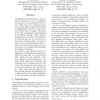190 search results - page 2 / 38 » A Dynamic Language Model Based on Individual Word Domains |
UML
2004
Springer
13 years 10 months ago
2004
Springer
Being part of domain engineering, domain analysis enables identifying domains and capturing their ontologies in order to assist and guide system developers to design domain-specifi...
ICB
2009
Springer
13 years 12 months ago
2009
Springer
Abstract. Fingerprints are considered to be unique because they contain various distinctive features, including minutiae, ridges, pores, etc. Some attempts have been made to model ...
ACL
2006
13 years 6 months ago
2006
Morphological disambiguation is the process of assigning one set of morphological features to each individual word in a text. When the word is ambiguous (there are several possibl...
CAISE
1999
Springer
13 years 9 months ago
1999
Springer
In this paper, we describe the process specification language ConGolog and show how it can be used to model business processes for requirements analysis. In ConGolog, the effects...
EMNLP
2010
13 years 3 months ago
2010
Almost all Chinese language processing tasks involve word segmentation of the language input as their first steps, thus robust and reliable segmentation techniques are always requ...

